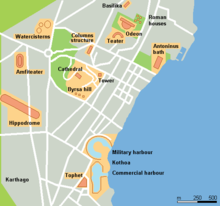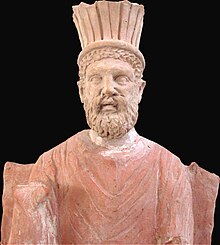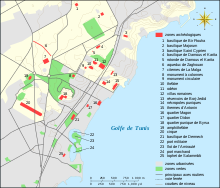Roman Carthage


Roman Carthage was an important city inancient Rome,located inmodern-day Tunisia.
Approximately 100 years after the destruction ofPunic Carthagein 146 BC, a new city of the same name (LatinCarthāgō) was built on the same land by theRomansin the period from 49 to 44 BC. By the 3rd century, Carthage had developed into one of the largest cities of theRoman Empire,with a population of several hundred thousand.[1]It was the center of the Roman province ofAfrica,which was a majorbreadbasketof the empire. Carthage briefly became the capital of an usurper,Domitius Alexander,in 308–311. Conquered by theVandalsin 439,[2]Carthage served as the capital of theVandal Kingdomfor a century. Re-conquered by theEastern Roman Empirein 533–534, it continued to serve as an Eastern Roman regional center, as the seat of thepraetorian prefecture of Africa(after 590 theExarchate of Africa). The city was sacked and destroyed byUmayyadArab forces after theBattle of Carthagein 698 to prevent it from being reconquered by the Byzantine Empire.[3]A fortress on the site was garrisoned by Muslim forces[4]until theHafsidperiod, when it was captured by Crusaders during theEighth Crusade.After the withdrawal of the Crusaders, the Hafsids decided to destroy the fortress to prevent any future use by a hostile power.[5]Roman Carthage was used as a source of building materials forKairouanandTunisin the 8th century.[6]
History[edit]

Foundation[edit]

After the Roman conquest of Carthage, its nearby rivalUtica,a Roman ally, was made capital of the region and for a while replaced Carthage as the leading centre of Punic trade and leadership. It had the advantageous position of being situated on the outlet of theMedjerda River,Tunisia's only river that flowed all year long. However, grain cultivation in the Tunisian mountains caused large amounts ofsiltto erode into the river. This silt accumulated in the harbour until it became useless, and so Rome looked for a new harbour town.
By 122 BC,Gaius Gracchushad founded a short-livedRoman colony,calledColonia Junonia.The purpose was to obtain arable lands for impoverished farmers. TheSenateabolished the colony some time later, to undermine Gracchus' power.
After this failed effort, a new Carthage was built on the same land of the old Carthage byJulius Caesarin the period from 49 to 44 BC; by the first century, it had grown to be the second-largest city in the western half of theRoman Empire,with a peak population of 500,000.[7][unreliable source?]It was the centre of theRoman province of Africa,which was a major breadbasket of the empire. Among its major monuments was anamphitheatre. Thetemple of Juno Caelestis,dedicated to the City Protector Goddess Juno Caelestis, was one of the biggest building monuments of Carthage, and became a holy site for pilgrims from all Northern Africa and Spain.[8]
Early Christianity[edit]
Carthage became acentre of early Christianity.In the first of a string of rather poorly reported councils at Carthage a few years later, no fewer than 70 bishops attended.Tertullianlater broke with the mainstream that was increasingly represented in the West by theprimacy of the Bishop of Rome,but a more serious rift among Christians was theDonatist controversy,against whichAugustine of Hippospent much time and parchment arguing. At theCouncil of Carthage (397),thebiblical canon for the western Church was confirmed.The Christians at Carthage conductedpersecutions against the pagans,during which the pagan temples, including the Temple of Juno Caelesti, were destroyed.[9]
The great fire of the second century, which swept through the capital of the governor of theprovince,made it possible to develop a hilly area of the city as part of an important urban planning project. A vast district of luxurious dwellings, including the "Villa de la volière", was built on this occasion. A circular monument, which was excavated during theUNESCOcampaign, called "rotonde sur podium carré",[10]is sometimes dated to the Christian period and identified by some researchers as a mausoleum.[11]A huge inscription toAesculapiuswas found nearby, which suggests that the Punic temple ofEshmunwas located on this site. Texts indicate that the Romans built the temple to the corresponding deity of their pantheon on the same site.[10]The last fundamental element of the building program is a large leisure area, with a theatre dating from the second century and an odeon built in the third century. According to Victor de Vita, the whole area was destroyed by theVandals.However, a remaining population lived there and a settlement persisted in the ruins.
Vandal period[edit]

The Vandals underGaisericlanded at theRoman province of Africain 429,[12]either at the request ofBonifacius,a Roman general and the governor of theDiocese of Africa,[13]or as migrants in search of safety. They subsequently fought against the Roman forces there and by 435[citation needed]had defeated the Roman forces in Africa and established theVandal Kingdom.[10]As anArian,Gaiseric was considered a heretic by theCatholicChristians, but a promise of religious toleration might have caused the city's population to accept him.
The 5th-century Roman bishopVictor Vitensismentions inHistoria Persecutionis Africanae Provinciathat the Vandals destroyed parts of Carthage, including various buildings and churches.[14]Once in power, the ecclesiastical authorities were persecuted, the locals were aggressively taxed, and naval raids were routinely launched on Romans in the Mediterranean.[15]
Byzantine period[edit]
After two failed attempts byMajorianandBasiliscusto recapture the city in the 5th century, theByzantine or Eastern Roman Empire,using the deposition of Gaiseric's grandsonHildericby his cousinGelimeras a "casus belli",finally subdued the Vandals in theVandalic Warof 533–534, the Roman generalBelisarius,accompanied by his wifeAntonina,made his formal entry into Carthage in October 533. Thereafter, for the next 165 years, the city was the capital ofByzantine North Africa,first organised as thepraetorian prefecture of Africa,which later became theExarchate of Africaduring the emperorMaurice'sreign. Along with theExarchate of Ravenna,these two regions were the western bulwarks of the Byzantine Empire, all that remained of its power in the West. In the early seventh centuryHeraclius the Elder,theExarchof Africa,rebelledagainst the Byzantine emperorPhocas,whereupon his sonHeracliussucceeded to the imperial throne.
Islamic conquest[edit]
The Exarchate of Africa first facedMuslim expansionfromEgyptin 647, but without lasting effect. A more protracted campaign lasted from 670 to 683 but ended in a Muslim defeat in thebattle of Vescera.Captured by the Muslims in 695, it was recaptured by the Byzantines in 697, but was finally conquered in 698 by theUmayyadforces ofHassan ibn al-Nu'man.Fearing that the Eastern Roman Empire might reconquer it, the Umayyads decided to destroy Roman Carthage in ascorched earth policyand establish their centre of government further inland atTunis.The city walls were torn down, the water supply cut off, the agricultural land ravaged and its harbours made unusable.[3]The destruction of the Roman Carthage and the Exarchate of Africa marked a permanent end to Roman rule in the region, which had largely been in place since the 2nd century BC.
It is visible from archaeological evidence that the town of Carthage continued to be occupied, particularly the neighbourhood of Bjordi Djedid. TheBaths of Antoninuscontinued to function in the Arab period and the historianAl-Bakristated that they were still in good condition. They also had production centres nearby. It is difficult to determine whether the continued habitation of some other buildings belonged to Late Byzantine or Early Arab period. The Bir Ftouha church might have continued to remain in use though it is not clear when it became uninhabited.[4]Constantine the Africanwas born in Carthage.[16]
The fortress of Carthage continued to be used by the Muslims until theHafsid eraand was captured in 1270 by Christian forces during theEighth Crusade.After the withdrawal of the Crusaders,Muhammad I al-Mustansirdecided tocompletely destroyit to prevent a repetition.[5]
Rediscovery[edit]
The ruins of Carthage were rediscovered at the end of the 19th century.[17]TheOdeonwas excavated in 1900–1901,[18]and the amphitheatre was excavated in 1904.
Amphitheatre[edit]
Odeon Hill[edit]
This sectionneeds additional citations forverification.(April 2023) |
Odeon Hill, located to the north-east of the archaeological site of Carthage, is the site of numerous Roman ruins, including the theatre, theodeon,and the park of the Roman villas. The park includes the villa of the aviary, the best preserved Roman villa of the site of Carthage.
The House of the Horses contains a mosaic of more than fifty circus horses, bordered by hunting scenes.[19]

The Odeon Hill has its name due to a misidentification of the building which was thought to be the Odeon, known to exist fromTertullian,but what tuned out to be a theatre.[20]Odeon hill and the park of the Roman villas are located to the east of the Roman colony of Carthage, and to the north of the park of theBaths of Antoninus.On its outskirts is now located the area of the presidential palace in the south, while in the north the Mâlik ibn Anas mosque has been built.
Theatre[edit]

Tertullianmentions in his introduction to theFlorides[21]the richness of the decoration, the splendour of the marbles of the cavea, the parquet floor of theprosceniumand the haughty beauty of the pillars.[22]There was a colonnade ofmarbleandporphyryon the frons scænae, numerous statues and quality epigraphic ornaments. The theatre extends over an area equivalent of about four blocks and dates probably to the times ofAugustus.[23]By size it is the second largest Roman theatre in Africa, only the one inUticais larger.[23]
Fragments of inscriptions found in the theatre refer to repairs made in the fourth century.[24]
The theatre is a mixture ofGreekandRoman theatre:the tiers are supported by a system of vaults, but take advantage of the slope of the hill.[25]Thecaveaconsisted of sections with tiers separated by stairs. The orchestra, with its more comfortable movable seats, was intended for VIP spectators. The pulpitum was a wall separating the orchestra from the stage, while the frons scænae formed the backdrop to the building. The odeon was entirely built, as it did not take advantage of the topography.
There are very few Roman remains of the stands in the present building. The theatre was renovated and since 1964 it is the site of theInternational Festival of Carthage.[26]The semicircular walls also date from the early 20th century when it was used for costume production.
Odeon[edit]

Only traces of substructures of theOdeonremain, barely cleared at the beginning of the 20th century. It was rediscovered byPaul Gaucklerwho lead the excavations between 1900 and 1901.[18]The Odeon was mentioned by the Christian theologist Tertullian and is where the Roman Emperor of African originSeptimus Severusshall have awarded the prize for the winner of theliterary competition.[27]The Odeon, which is considered to be the largest Roman Odeon, lies adjacent to the southern theatre and occupies three city blocks.[28]It had a seating capacity of about 20,000 spectators and it was not assumed to be an Odeon were it not for the inscription ODEVM discovered in a cistern under the stage.[28]In comparison, the second largest romanOdeon in Athenshad a seating capacity of 5,000.[28]
Excavations took place again between 1994-2000 by researchers from the School of Architecture of theUniversity of WaterlooinOntarioand theTrinity UniversityinTexas.[18]Although the site is located in anon aedificandizone, it is now situated in the immediate vicinity of the Mâlik ibn Anas Mosque. The building, which stood against the theater and was built entirely above ground level, had semi-circular corridors for the circulation of visitors. Tertullian mentions the discovery of burial sites during the construction of the building.Timothy Barnesassumed it to have been built around 200 BC.[29]
Roman villas[edit]

The relics of the villas are in a mediocre state, except for those of the villa of the aviary. The main interest of the district consists in the vision of a neighbourhood of theColonia Iulia Carthago,organised ininsulaeor small islands of 35 meters by 141 meters.
The second-century district has orthogonal streets, "successive tiers crammed into the sides of the hill";[30]the upper tier is located in the ground, the lower tier opens onto the street above the lower tier. The flats were located on the upper floor, with the shops occupying the ground floor at street level.
The villa is the main feature of the park, due to the quality of the restoration carried out in the 1960s.[31]The name of the villa comes from themosaicof the aviary, marked by the presence of birds among thefoliage,[30]which occupies the garden, in the centre of theviridarium,the heart of a square courtyard framed by a portico decorated with pink marble pillars.
To the southwest is a terrace that opens onto the street. To the west, a vaulted gallery also serves as a relief from the pressure of the ground, while the building'satriumis located to the east. To the north are all the prestige rooms, the ceremonial flats, thelaraireand thevestibule.
Upstairs were the baths and shops. On the upper floor were the private flats of the owners, with shops under the terraced portico. Below thecryptoporticuswas a weatherproof promenade.
Baths of Antoninus[edit]

The Baths of Antoninus or Baths of Carthage are the largest set of Romanthermaebuilt on theAfrican continentand one of three largest built in the Roman Empire. They are the largest outside mainland Italy.[32]The baths are also the only remaining Thermae of Carthage that dates back to theRoman Empire's era.The baths were built during the reign of Roman EmperorAntoninus Pius.[33]The baths continued to function in the Arab period: the historianAl-Bakristated that they were still in good condition.[citation needed]
The baths are at the South-East of the archaeological site, near the presidentialCarthage Palace.The archaeological excavations started during theSecond World Warand concluded by the creation of an archaeological park for the monument. It is also one of the most importantlandmarks of Tunisia.[citation needed]
Circus[edit]

The Circus of Carthage was modelled on theCircus Maximusin Rome. Measuring more than 470 m in length and 30 m in width,[34]it could house up to 45,000 spectators, roughly one third of the Circus Maximus, and was used forchariot racing.
The building appears to have been constructed sometime around 238 AD, and was used for several years before its official dedication.
Remains from the Circus Maximus, specifically the marble "spina" (a dividing barrier) were used in the Circus of Carthage, as well as the Circus of Maxentius and the city of Vienne located in France.[35]
See also[edit]
- Bardo National Museum
- Baths of Antoninus
- Carthage National Museum
- Carthage Paleo-Christian Museum
- Carthage
- History of Carthage
References[edit]
- ^Likely the fourth city in terms of population during the imperial period, following Rome,AlexandriaandAntioch,in the 4th century also surpassed byConstantinople;also of comparable size wereEphesus,SmyrnaandPergamum.Stanley D. Brunn, Maureen Hays-Mitchell, Donald J. Zeigler (eds.),Cities of the World: World Regional Urban Development,Rowman & Littlefield, 2012,p. 27
- ^Peter Heather (2010).The Fall of the Roman Empire: A New History.Pan Macmillan. p. 402.ISBN9780330529839.
- ^abC. Edmund Bosworth (2008).Historic Cities of the Islamic World.Brill Academic Press. p. 536.ISBN978-9004153882.
- ^abAnna Leone (2007).Changing Townscapes in North Africa from Late Antiquity to the Arab Conquest.Edipuglia srl. pp. 179–186.ISBN9788872284988.
{{cite book}}:|work=ignored (help) - ^abThomas F. Madden; James L. Naus; Vincent Ryan, eds. (2018).Crusades – Medieval Worlds in Conflict.Oxford University Press. pp. 113, 184.ISBN978-0-19-874432-0.
- ^Colum Hourihane (2012).The Grove Encyclopedia of Medieval Art and Architecture, Volume 1.Oxford University Press.ISBN978-0-19-539536-5.
- ^"Bridges That Babble On: 15 Amazing Roman Aqueducts,Article by Steve, filed under Abandoned Places in the Architecture category ".26 September 2010.
- ^McHugh, J. S. (2015). The Emperor Commodus: God and Gladiator. (n.p.): Pen & Sword Books.
- ^Brent D. Shaw (September 2011).Sacred Violence: African Christians and Sectarian Hatred in the Age of Augustine.Cambridge University Press.ISBN9780521196055.Archived fromthe originalon 2022-11-26.Retrieved2023-04-11.
- ^abcPicard (1951,p. 42)
- ^Ennabli & Slim (1993,p. 55)
- ^Roger Collins."Vandal Africa, 429–533", XIV.Cambridge University Press. p. 124.
- ^Procopius Wars 3.5.23–24 in Collins 2004, p. 124
- ^Anna Leone (2007).Changing Townscapes in North Africa from Late Antiquity to the Arab Conquest.Edipuglia srl. p. 155.ISBN9788872284988.
{{cite book}}:|work=ignored (help) - ^Thomas Brown; George Holmes (1988).The Oxford History of Medieval Europe.Great Britain: Oxford University Press. p. 3.
- ^Charles Singer (29 October 2013).A Short History of Science to the Nineteenth Century.Courier Corporation.ISBN9780486169286.
- ^"The Princeton Encyclopedia of Classical Sites, CABANES (" Ildum ") Castellón, Spain., CARCASO (Carcassonne) Gallia Narbonensis, Aude, France., CARTHAGE Tunisia".perseus.tufts.edu.Retrieved2023-01-20.
- ^abcColin M. Wells (2004)."A Cuckoo in the Nest: The Roman Odeon at Carthage in its Urban Context".American Journal of Ancient History (New Series 3-4, 2004-2005 [2007]).Gorgias Press.p. 134.doi:10.31826/9781463213930-007.ISBN9781463213930.
{{cite book}}:|website=ignored (help) - ^Katherine M. D. Dunbabin (1999).Mosaics of the Greek and Roman World.Cambridge University Press. p. 116.ISBN9780521002301.
- ^Colin M. Wells (2004)."A Cuckoo in the Nest: The Roman Odeon at Carthage in its Urban Context".American Journal of Ancient History (New Series 3-4, 2004-2005 [2007]).Gorgias Press.pp. 131–132.doi:10.31826/9781463213930-007.ISBN9781463213930.
{{cite book}}:|website=ignored (help) - ^Ennabli & Slim (1993,p. 50)
- ^Picard & (1951,p. 43)
- ^abColin M. Wells (2004)."A Cuckoo in the Nest: The Roman Odeon at Carthage in its Urban Context".American Journal of Ancient History (New Series 3-4, 2004-2005 [2007]).Gorgias Press.p. 133.doi:10.31826/9781463213930-007.ISBN9781463213930.
{{cite book}}:|website=ignored (help) - ^Ennabli & Slim (1993,p. 48)
- ^Ennabli & Slim (1993,p. 49)
- ^Roua Khlifi (14 August 2015)."Carthage International Festival continues to shine from Roman amphitheatre".Arab Weekly.Retrieved2023-01-20.
- ^"Overview".tunisiepatrimoine.tn(in Danish). 2 October 2022.Retrieved2023-01-20.
- ^abcColin M. Wells (2004)."A Cuckoo in the Nest: The Roman Odeon at Carthage in its Urban Context".American Journal of Ancient History (New Series 3-4, 2004-2005 [2007]).Gorgias Press.pp. 133–134.doi:10.31826/9781463213930-007.ISBN9781463213930.
{{cite book}}:|website=ignored (help) - ^Colin M. Wells (2004)."A Cuckoo in the Nest: The Roman Odeon at Carthage in its Urban Context".American Journal of Ancient History (New Series 3-4, 2004-2005 [2007]).Gorgias Press.p. 135.doi:10.31826/9781463213930-007.ISBN9781463213930.
{{cite book}}:|website=ignored (help) - ^abPicard (1951,p. 44)
- ^Ennabli & Slim (1993,p. 51-52)
- ^"Where climate change threatens ancient sites and modern livelihoods".The Christian Science Monitor.10 February 2020.
- ^"How many ancient cities do you know? Quiz answers".TheGuardian.15 November 2013.
- ^Humphrey, J.H. (1986).Roman Circuses: Arenas for Chariot Racing.University of California Press. p. 446.ISBN9780520049215.Retrieved2015-08-14.
- ^Peck, Harry Thurston (1897)."Harper's Dictionary of Classical Literature and Antiquities".
- Sources
- Ennabli, Abdelmajid; Slim, Hédi (1993).Carthage le site archéologique(in French). Paris: Cérès. p. 91.ISBN978-9973700834.
- Picard, Colette(1951).Carthage(in French). Paris:Les Belles Lettres.p. 100.
- Heather, Peter (2004).The Fall of the Roman Empire: A New History.Pan Macmillan. p. 402
Further reading[edit]
- Auguste Audollent(1901),Carthage Romaine, 146 avant Jésus-Christ — 698 après Jésus-Christ,Paris.
- Ernest Babelon,Carthage,Paris (1896).
- S. Raven (2002),Rome in Africa,3rd ed.
- Byzantine North Africa
- Roman towns and cities in Tunisia
- Populated places of the Byzantine Empire
- Populated places established in the 1st century BC
- Populated places disestablished in the 7th century
- 1st-century BC establishments in the Roman Republic
- 698 disestablishments
- 7th-century disestablishments in the Exarchate of Africa
- 7th-century disestablishments in Africa
- Destroyed populated places
- Carthage
